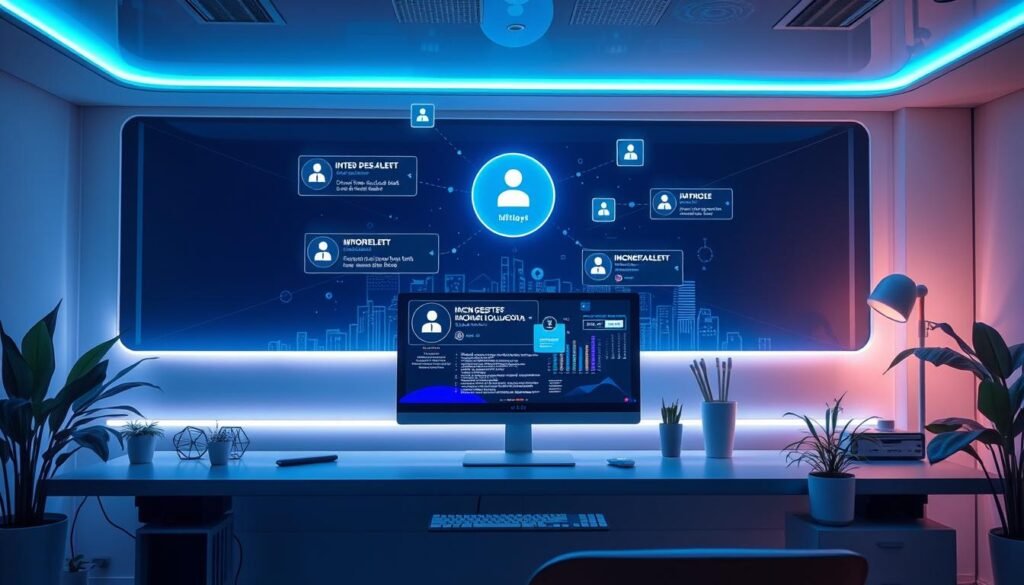Did you know an average worker checks their email and chats every six minutes? They handle over 56 apps and tools daily. This fact shows the big issue of notification fatigue. We live in a time where alerts hit us from all sides. It’s hard for many to keep focused and be productive. Notification fatigue comes from too many alerts. It causes more stress and less responsiveness. This article gives practical ways to fight notification fatigue. It helps improve focus in this chaotic alert-filled world. By knowing where too many alerts come from and their effect on work, people can take back control of their digital lives.
Key Takeaways
- Notification fatigue severely diminishes productivity and responsiveness.
- Professionals, especially remote workers, are particularly vulnerable to alert overload.
- Custom notification settings are essential for managing incoming alerts effectively.
- Digital minimalism offers a promising strategy to reduce distraction.
- Regularly evaluating notification systems can optimize user experiences.
- Tools like MagicBell and PagerDuty help tailor notifications to individual needs.
Understanding Notification Fatigue
Notification fatigue happens when people get too many alerts, making them feel mentally drained. It comes from work reminders, social media, and bad news. This mix causes a state known as doomscrolling. As these alerts pile up, our minds can’t keep up. We start missing important messages and feel overwhelmed.
Our world is full of technology, leading to too much time on screens. In 2022, there was a big jump in mobile app downloads, reaching 255 billion. That’s 80% more since 2016. In 2023, studies showed that being online too much is frustrating for many. This is especially true after COVID-19 hit.
Alert fatigue is a big deal. When apps send more than five notifications a week, users often want to delete them. Yet, if notifications match what users like, they keep them engaged. Personalized alerts, like using someone’s name, help fight fatigue. They make alerts feel more relevant.
Companies need to see the mental impact of too many alerts. It affects how well we work and even cybersecurity. In cybersecurity, about 30% of alerts are ignored. This raises the risk of security problems.
To tackle notification fatigue, setting smart limits on alerts is key. This helps reduce stress from too many notifications and makes sure we don’t miss the important ones. The aviation industry offers great examples. They show how custom alerts can really help reduce fatigue. To learn more about handling alert fatigue, check this resource.
The Impact of Alert Overload on Productivity
Today’s work world moves fast, making alert overload a big problem. About 16% of Security Operations Center (SOC) pros can only handle 50-59% of their alerts weekly. They get around 500 alerts that need checking every week. This shows why too many alerts drop productivity a lot.
For SOC teams, 65% of their time goes into checking alerts. This causes stress and hurts mental health. Big companies deal with thousands of alerts each day. This makes it hard to stay clear-headed and focused. Feeling swamped by alerts slows down reactions and increases the chance of missing important ones.
Many security teams operate with understaffing, compounding the burden as they resort to manual processes in managing high alert volumes.
Alert fatigue makes people pay less attention to alerts over time. It also eats up more resources. Handling false alarms and bad settings make things worse. Using smart tech like Cybereason’s platform helps. It cuts down on overload by helping to figure out which alerts matter most.
| Alert Fatigue Characteristics | Alert Noise Characteristics |
|---|---|
| Decreased attention to alerts over time | High volume of alerts, including many false positives |
| Slower response times to notifications | Difficulty in distinguishing between critical and non-critical alerts |
| Increased likelihood of missing critical alerts | System overload leading to delayed processing of alerts |
| General feeling of being overwhelmed by constant notifications | Increased resource consumption in managing and triaging alerts |
Dealing with alert overload is key to getting productivity back on track. It also helps people feel better at work. Making sure teams handle the big stuff without drowning in notices boosts happiness and work quality.
Identifying the Causes of Notification Fatigue
Notification fatigue is common, especially among cybersecurity experts dealing with endless alerts. One key cause of notification fatigue is the sheer number of alerts users receive. Since 2020, the number of alerts has jumped by 97%. This huge amount of notifications causes cognitive overload. It also makes completing tasks 28% less efficient.
Another issue is low prioritization in alert systems. When systems fail to highlight the important alerts from the less urgent ones, users may miss something critical. Also, systems that send out too many alerts, including ones that aren’t needed, make it hard to spot the really important updates. For example, setting the sensitivity too high can lead to unneeded warnings. This makes it hard to tell the difference between crucial updates and minor ones.
About 60% of users stop following alerts they think are irrelevant. This shows they struggle with too many repeat notifications. Also, small and medium-sized companies often don’t have enough staff. Their IT teams are already doing a lot, which leads to alert fatigue.
Older systems add to the problem as they usually can’t filter alerts well. As cyber threats get more complex, the need for broader detection grows. This often results in more false alarms, which adds to alert fatigue. Studies show that businesses using old alert systems feel overwhelmed. This leads to a higher risk of missing critical alerts.
| Causes of Notification Fatigue | Description |
|---|---|
| High Volume of Alerts | Overwhelming number of notifications leading to cognitive overload and reduced efficiency. |
| Low Prioritization | Difficulties in distinguishing critical alerts from non-urgent notifications, resulting in missed alerts. |
| Repetitive Alerts | Excessive non-critical notifications that condition users to ignore crucial updates. |
| Poor System Configuration | Overly sensitive thresholds triggering unnecessary alerts contribute to user fatigue. |
| Inadequate Staffing | IT teams overwhelmed with tasks, unable to manage alerts effectively leading to fatigue. |
| Legacy Systems | Outdated mechanisms that lack sophistication to filter and prioritize notifications. |
The Effects of Notification Anxiety and Attention Scarcity
Notification anxiety affects many due to constant alerts. It comes from needing to always pay attention, creating a feeling of urgency. People feel they must respond right away. This leads to a lack of focus. As a result, doing deep, meaningful work becomes hard.
This issue can cause mental overload. It strains the mind a lot. Studies show that 74% of those who rely heavily on smartphones face mental health issues because of too many notifications. This causes tiredness and annoyance. Social media makes it worse, with people checking their phones often.
This leads to feeling disconnected and even more tired. Spending too much time on social media also ups anxiety and bad moods.

It’s important to understand this problem for our well-being. Notification overload is more than just annoying. It poses real challenges in life and work. People trapped in this cycle may find little joy in their jobs. This can lower their life’s happiness. Finding a balance is key to avoid the downsides of constant notifications.
| Aspect | Impact of Notification Anxiety |
|---|---|
| Psychological Effect | Increased stress and urgency |
| Productivity | Decline in focus and efficiency |
| Social Media Impact | Feelings of exhaustion and irritation |
| Link to Mental Health | Higher levels of anxiety and depressive symptoms |
Strategies to Reduce Push Disruption
To reduce push disruption, adopting different focus strategies is crucial. One way is prioritizing notifications by importance. This method ensures you see important messages quickly and less urgent ones later. Using “Do Not Disturb” during work times also helps avoid interruptions.
Another method is to clean up your notification settings regularly. By only allowing essential app alerts, you can lower your anxiety. Studies show that fewer notifications can also increase your focus and productivity.
Creating a system to prioritize alerts can be useful too. You could use a three-tier system: Critical, Priority, or Informational. This helps you know which notifications need immediate attention, lowering stress from too many alerts.
Also, customizing how you get alerts can make a big difference. Considering we get around 18 billion SMS messages and 306.4 billion emails daily, personalized management is key. It helps you stay on top of things without feeling overwhelmed.
To learn more about handling notification fatigue and keeping engaged, check out this useful guide. By using these tips, you can find a good balance between being informed and focused.
Digital Minimalism: A Solution to Combat Notification Fatigue
Digital minimalism is a strong way to tackle notification fatigue, common in our digital world. By limiting digital use, people can focus on mindful technology use. This improves productivity and happiness.
Professor Cal Newport introduced digital minimalism. He highlighted three key ideas: clutter is costly, optimization is important, and intentionality is satisfying. Following these ideas helps people handle notifications and distractions better.
Every day, people get bombarded with notifications. This causes a lot of mental fatigue. By setting goals and stopping unnecessary subscriptions, one can ease their mind. Keeping important notifications, like calls and texts, makes it easier to focus.
Monitoring how you use your devices can show you how you spend your time. This helps to set limits, like using social media only twice a day. Having digital-free zones at home promotes a healthier tech relationship.
Taking up hobbies without screens and valuing in-person talks helps to build stronger bonds. Removing unused apps or not scrolling without a purpose cuts down on digital clutter. This boosts concentration and leads to better productivity.
Reviewing your progress and making necessary changes can help you stay on track with digital minimalism. This method leads to a balanced life, focusing on what’s important and keeping connections meaningful. For more tips on overcoming decision fatigue from digital overload, visit this resource on decision fatigue.
Establishing Critical Alerts and Filtering Out Noise
In our world today, it’s key to set up critical alerts to stay focused. Security teams get about 4,484 alerts every day. So, knowing which alerts need urgent action can cut down on unnecessary stress.
It’s important to decide what makes an alert critical. Doing so depends on how it affects work and how urgent it is. Predictable alerts follow a pattern and don’t often surprise us. Yet, flappy alerts change often and can tire us out. To handle these, set up checks to confirm an issue is fixed. This cuts down on annoying alerts.
Grouping notifications is a smart way to handle them. Group alerts by criteria like service or cluster name to manage the flood of messages. Using conditions in alerts helps make sure only key info gets to the right people.
Setting mute times during updates or maintenance helps too. Tools like Datadog show which alerts are most frequent, comparing new alerts to past data. This helps in managing alerts better.
Using these methods helps fight alert overload and creates a better workplace. Quieting non-urgent alerts at night and combining related alerts, as PagerDuty does, aids in managing alerts. By doing this, teams can focus on what matters without feeling swamped.
Implementing Intelligent Alert Systems
In today’s world, having effective notification management is key for keeping things running smoothly. Intelligent alert systems are vital in making this happen. They use the latest technology to sort notifications by importance and urgency. This method helps control alert overload, especially in busy places like network and security operations centers.

One big plus of these smart systems is they cut down on false alerts. Old-school ways can flood IT experts with too many messages, causing them to overlook important ones. By applying AI and machine learning, these systems weed out alerts that don’t require action. This sharpens alert prioritization and boosts how effectively teams respond. For example, AIOps slashed alert noise by 94% for Tivo, proving the real-world impact of such tech.
Another point to consider is the risk of employee burnout in high-alert settings. Constant alerts can reduce job happiness and performance. Smart alert systems help avoid this by being more user-friendly and efficient. This can lead to happier, more productive workers.
Looking ahead, the future of alert management seems promising. It includes:
- Better AI and machine learning for fine-tuning alert sorting.
- Wearable tech to keep an eye on alert fatigue in real-time.
- User-friendly designs that make handling alerts easier.
- Collaborative platforms for quick handling of key issues.
By improving in these parts of notification management, companies can maintain better operations. They can also avoid the pitfalls of missing crucial alerts. In a nutshell, smart alert systems don’t just make responses more accurate. They create a more productive IT environment too.
Learn more about how tackling alert fatigue can make IT systems perform better and be more resilient. Check out this valuable resource.
Minimizing Mobile Distraction and App Spam
Mobile devices easily distract us, especially with too many app notifications. The average company uses about 291 apps. This heavy use leads to app fatigue. Trying to keep up with these can be exhausting. Each new notification distracts us from our work. This causes lots of interruptions, making tasks take longer to finish.
There are ways to fight against app spam. First, delete apps you don’t use that add no value. Checking notification settings often helps limit unwanted alerts. A unified system like Nextiva’s business software can make things simpler. It combines chatting, emailing, and video calling in one place. This means fewer apps to switch between.
It’s smart to have rules for taking breaks from digital devices. Such breaks can reduce app fatigue and improve how we use technology. Making time for phone-free meetings encourages more real-life conversations. In today’s world, face-to-face interaction is crucial but often overlooked due to screen time.
To cut down distractions, being selective about apps and their notifications is vital. Making small changes can greatly improve our mental well-being. It helps us focus better, boosts productivity, and takes care of our mental health.
Taking a Break from Technology: The Opt-Out Method
The opt-out method offers a way to deal with too much screen time. About 61% of people say they’re hooked on the internet. Taking regular breaks from tech can make one feel refreshed. This approach helps you focus better and clear your mind.
Taking time off from screens has big benefits. Setting aside tech helps lower stress and promotes careful use. Studies show changing how we use smartphones boosts productivity. It helps to keep phones out of reach at meals or late at night.

A digital detox can fight the negative effects of too much phone use. These include feeling bad about oneself and not paying attention. Limiting screen time betters mental and physical health. After a break, entrepreneurs often find they’re more creative. This proves stepping back helps focus more on important projects.
Seeking a balance is key. A break from tech lets you think deeply. This makes you more ready to tackle both personal and work tasks.
| Benefits of Technology Break | Effects of Excessive Use |
|---|---|
| Improved focus and productivity | Low self-esteem and anxiety |
| Reduced stress levels | Disrupted sleep patterns |
| Enhanced creativity | Physical health issues, e.g., eye strain |
| Better environmental awareness | Time management and work ethic problems |
The opt-out method does more than build good habits. It also creates a space that helps innovation and wellness thrive. Taking a thoughtful approach to using tech can lead to a more focused, balanced life.
Practicing Attention Resistance in Daily Life
In our world full of constant alerts, learning to resist them is key. By not reacting to every notification, we improve our thinking abilities and get more done. Working on our focus is a big part of this. It helps us pick what’s important and dedicate time to work without interruptions.
Using time-blocking helps a lot with resisting distractions. When we set apart specific times for work, we’re less tempted to keep checking our phones. Being fully in the moment during these times boosts our creativity and work quality. Having set times to look at notifications can also cut down on interruptions.
Adding mindfulness meditation to our daily life strengthens our resistance to distractions. It gives us tools to stay focused and not get sidetracked. This goes hand-in-hand with practicing focus. Together, they prepare us to handle today’s challenges better.
- Engage in time-blocking for uninterrupted work sessions.
- Prioritize mindfulness meditation to enhance present-moment awareness.
- Schedule specific times to check notifications and stick to them.
- Embrace focus practice to strengthen attention resistance against distractions.
By regularly working on resisting distractions, we can change our daily routines for the better. This leads to better concentration and less stress. Living this way lets us enjoy a more meaningful and productive life amidst the noise of the world.
Conclusion
Today, it is vital to fight notification fatigue to boost our productivity and keep our life quality high. Understanding this issue helps us take back control over where we focus our attention. It’s key to narrow down our alerts to increase our involvement.
Spotting fatigue symptoms early is important. This way, we can act fast to stay on top of things. By adopting smart alert systems, organizations make sure only important messages get through. This helps teams act quickly on what matters most.
To really overcome notification fatigue, we must adopt better digital habits. This boosts our focus at work and in life. For tips on staying alert without getting overwhelmed by notifications, check out this guide on preventing fatigue.